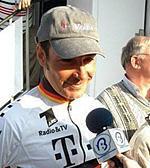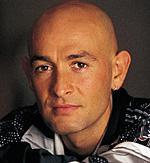Special Edition Cycling News for April 1, 2004Edited by Jeff Jones, Chris Henry, John Stevenson and Anthony Tan Zabel asks for height regulations to podiums
Possibly as a consequence of his recent string of second places, the world's number one-ranked rider, Erik Zabel (T-Mobile Team), has called upon the UCI to introduce height regulations to podiums, and in particular, to reduce the height differential between the first and second step. "Everyone knows who has won and who has lost, so why do the race organisers have to rub it in and have such big gaps?" asked Zabel to Cyclingnews. "It is only April 1, and already I have finished second eight times and third six times. Everyone knows how a sprinter thinks: second is the first loser!" "On one occasion when I came third at the Vuelta a Murcia, I went to put my arm around Max van Heeswijk for the photographers, and I accidentally grabbed his left buttock," he added, citing another problem. "That was very embarrassing indeed!" To avoid this sort of humiliation recurring, Zabel has suggested that the UCI introduce a maximum 15 centimetre gap between the first and second step and a 30 centimetre gap between the first and third step of the podium. And while the sprinter from Berlin acknowledges it must be clear who has won, to have no podium at all is also unsuitable, as he found after finishing second to Oscar Freire in Milan-San Remo. "Actually, in San Remo, they didn't have any step at all, and because I am taller than Freire, some people thought I was the winner. That made me feel even worse for celebrating too early on the finish line." Pantani clone plan uncovered
A mysterious religious cult plans to clone Marco Pantani, according to a source inside the organisation who agreed to speak to Cyclingnews only on condition of complete anonymity. Clonaid, the cloning company set up by the Raelian organisation, intends to resurrect Pantani as "a mark of respect for the many, many people worldwide who were touched be the loss of this great rider," according to the source. It seems the Pope is not the only religious leader to be a cycling fan, as the decision to clone Pantani came right from the top of the Raelian Movement. The movement's French leader, Rael was a journalist before his 1973 conversation with extra-terrestrials inspired him to found the movement, and is a lifelong cycling fan, according to our source. "Rael was there in 1998 when Pantani won on Alpe d'Huez and went on to win the Tour," said our source. "Though he's known as a car racing driver, he also has a passion for cycling. He was deeply moved by the news of Pantani's death and immediately instructed Clonaid to investigate the possibility of cloning him. Samples of Pantani's tissue were obtained through Raelian Movement contacts in Italy and a host mother recruited from within the movement. All that remains is for Clonaid's laboratory to successfully meld the DNA from one of Pantani's cells with one of the host mother's eggs. Clonaid has claimed several successful human cloning experiments in recent years, but has never produced enough evidence to satisfy skeptics. Horner opens with a win in Sea OtterTop US domestic pro Chris Horner (Webcor) has done a scorching time in the opening stage of the Sea Otter Classic, a short time trial at Laguna Seca race course. Horner, riding a standard road bike, clocked a time of 3'30 for the three kilometres, and was justifiably pleased. "I'm very happy with the time, which should put me in the leader's jersey once the rest of the riders complete their rides," Horner told Cyclingnews. "I came here straight after Redlands to do the prologue. I figured it would be good to get it out of the way before all the crowds came. Sea Otter is like a mosh pit when the race is on." With another 14 days before the next rider sets off, Horner is guaranteed of being in virtual yellow for that period of time, perhaps longer if no-one can beat it. Such is his dominance in the early (and late) season races in the US, Horner was specially invited by the organisers of Sea Otter to set a benchmark time for the others to aim it. The extra two weeks will give competitors a chance to ride the course and fine tune their TT machines, although Horner's time will clearly be tough to beat. "I'm looking forward to stage 2," added Horner, who intends to ride the circuit race on Laguna Seca Raceway on Friday. Although the lack of competitors and teammates will mean that there's no-one to draft from, Horner doesn't see this is a great setback. "By riding the race solo, I can take the perfect lines through all the corners, and this will even out the disadvantage of having no bunch." Horner is expected to win the Sea Otter Classic when it finishes with a 100 mile road race through the Carmel and Salinas Valleys, ending on the Laguna Seca race way. But before then, he will start planning and riding his next NRC event. US Teams consider outsourcingGiven the fragile economic climate in the United States, American professional teams have begun investigating the possibilities of outsourcing to nations with experienced but less expensive work forces. India and China are two countries most often cited as labor sources for large US companies, and cycling team sponsors are following suit in their quest for a better return on their investment. "The fact is, there is a sizeable pool of talented cyclists in Asia and the subcontinent, and it makes perfect sense for us to tap into that," said Jo B. Steiler, corporate relations manager for Momentus, a multi-national consulting firm which plans to enter the US Division III ranks in 2005. "Cycling is an international sport, and we feel we can support the sport with a team in the United States while at the same time taking advantage of the opportunities in overseas labor. It's just good business." UCI Regulations require the majority of the riders on a team to come from the country in which the team is registered, but Steiler expects other sponsors to follow his lead, leading to a boom in diversification in the domestic peloton. "Outsourcing has become a hot topic in this country of late," said Steiler, "but in cycling diversity can only bring additional benefits." A USA Cycling spokesman applauded the move, saying, "If a large number of teams outsource their riders to countries such as India and China, it would make sense for USA Cycling to move its race series to those countries too. We would expect to achieve substantial cost savings and improved quality of promotions with such a move, and we don't think US race fans will mind that they will be unable to watch any of their national series events." UCI Bans 'third wheels'Concerned about the ability of riders to procure performance enhancing drugs from suppliers who may or may not even be affiliated with their teams, the UCI has announced a plan to ban what it refers to as 'third wheels', meaning all non-essential staff, at professional races. The move follows the lead of French sports minister Jean-Francois Lamour and his requirement that all massage be practiced only by licensed physical therapists instead of technical assistants, commonly referred to as soigneurs. The UCI is eager to keep the number of fringe staff members and hangers-on to a minimum at all races, hoping that riders will no longer be offered banned substances from unaccountable sources. "There are simply too many unnecessary staff personnel on the professional circuit," a UCI statement read. "The UCI understands that to better fight doping in cycling it must be able to keep watch over the people with whom cyclists have contact before and after events." Non-essential staff likely to be covered by the ban include riders' wives and girlfriends (or husbands and boyfriends in the case of female racers), personal assistants, secretaries, bag-carriers, second assistant directeurs sportifs, sous-chefs, gaffers, best boys and grips. While no implementation date has been set, it is expected that the new rules banning non-essential staff will take effect before the Giro d'Italia. A meeting of the Professional Cycling Council (PCC) is scheduled for the end of April. Introducing... Maximum Grothe 2000Cyclists are always looking to get the edge, but with drug testing rules as they are now, it's becoming increasingly difficult to do so without resorting to banned performance enhancing drugs. That's why Cyclingnews has developed Maximum Grothe 2000, a product that combines the best aspects of the immensely popular Git Huge 2000 and Go Fast 2000, but is guaranteed to make you fail a drug test. That's right, if you have to go to a doping control after taking Maximum Grothe 2000, there is a 100 percent chance that you will test positive for a banned substance. The patented formula has drugs in it with a half life of approximately 4,000 years, so there is no risk at all that you can test negative. In fact, it's so potent that a negative result can be used as proof that modern drug testing isn't all that it's cracked up to be. Maximum Grothe 2000 also covers those annoying blood tests. Concerned that your hematocrit is too low? Maximum Grothe 2000 guarantees to boost it by at least 15 percent, within hours of ingestion. That two week break you've been hanging out for is just around the corner. So, what actually goes into Maximum Grothe 2000 to provide these guaranteed results? That has to remain a secret of course, but we can reveal that our R&D staff had extensive talks with the (temporarily) retired pro Jesus Manzano, who despite taking nearly every substance on the banned list, never tested positive. Manzano was able to advise us on the drugs that he never dared to take, but will certainly lead to some interesting spikes on the GCMS readout. We also make no claims about the performance enhancing capabilities of Maximum Grothe 2000. On the one hand, it may make you rider faster for longer, but on the hand, testing carried out on cancerous rats caused most of them to develop an elevated heart rate, incontinence, hypotension, hypertension, hot and cold sweats, depression, paranoia, violent behaviour, headaches, excessive urination or thirst, diarrhea, vomiting, drowsiness, dizziness, muscle weakness, anxiety, difficulty concentrating, nausea, loss of appetite, delirium, hallucinations, agitation, seizures, hepatitis, gallbladder disease and death. Use Maximum Grothe 2000 at your own risk, without doctor's supervision.
Previous News Next News (All rights reserved/Copyright Knapp Communications Pty Limited 2004) |

|
January 2009 |
Recently on Cyclingnews.com |


